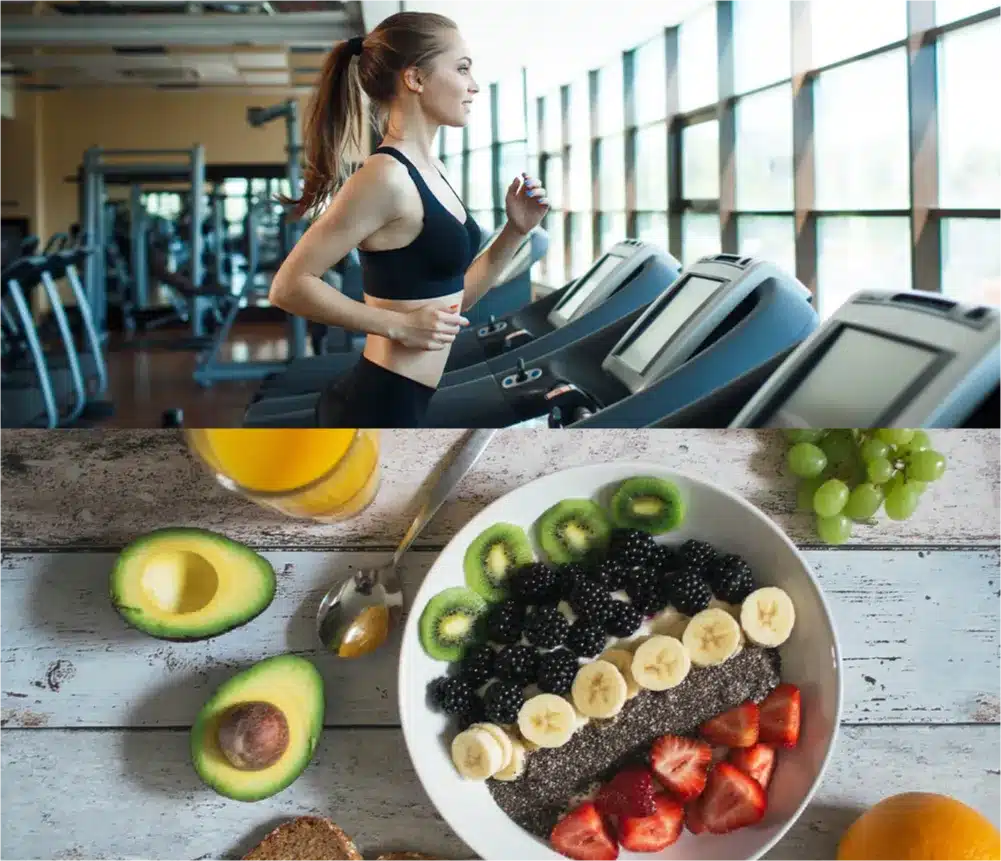Intermittent fasting (IF) has become one of the most popular methods for weight loss and overall health improvement. But did you know that pairing intermittent fasting with exercise can accelerate fat loss, enhance muscle preservation, and improve your overall fitness results? By understanding how fasting impacts your body during exercise and planning your workouts accordingly, you can optimize fat burning while maintaining muscle mass.
In this article, we’ll explore how to combine intermittent fasting with exercise for maximum fat loss, including the best workout times, types of exercise to prioritize, and how to fuel your body for optimal performance.
1. How Does Intermittent Fasting Affect Exercise?
Before diving into workout strategies, it’s important to understand the impact of fasting on your body during exercise:
- Increased Fat Burning: When you fast, your insulin levels drop, and your body switches from burning glucose (carbs) to burning stored fat for energy. This fat-burning process is known as “fat oxidation.” Exercising in a fasted state can increase fat utilization as a fuel source, leading to more fat loss.
- Improved Insulin Sensitivity: Fasting improves insulin sensitivity, which helps your body use glucose more effectively. This can reduce fat storage and promote lean muscle mass, especially when combined with resistance training.
- Human Growth Hormone (HGH) Boost: Fasting naturally increases the production of human growth hormone, which plays a key role in muscle growth and fat loss. HGH is elevated during fasting and exercise, helping preserve muscle tissue and burn fat more efficiently.
- Energy Availability: While fasting may initially seem like it could drain your energy for workouts, many people report feeling more focused and energetic once they adapt to fasting. However, it’s essential to listen to your body and not overstrain yourself, especially in the beginning stages of fasting.
2. Best Times to Exercise While Fasting
The timing of your workouts in relation to your fasting window plays a crucial role in maximizing fat loss:
- Exercising in a Fasted State (Morning or Before Your First Meal):
- Pros: Working out on an empty stomach, especially in the morning, can increase fat burning because your body has lower insulin levels, which allows for greater fat oxidation. Many people choose to do cardio in the morning while fasting for this reason.
- Best for: Low to moderate-intensity activities like walking, jogging, cycling, or steady-state cardio.
- Tip: Keep your intensity moderate to prevent muscle loss or fatigue. Intense exercise on an empty stomach can be stressful for some individuals, so listen to your body.
- Exercising After Breaking Your Fast:
- Pros: If you’re doing high-intensity workouts, like weight lifting or HIIT (high-intensity interval training), it may be better to exercise after you’ve eaten. Your body will have more glycogen (stored carbohydrates) available from your meal, helping you perform better and recover faster.
- Best for: Strength training, high-intensity interval training (HIIT), or any strenuous exercise.
- Tip: Have a balanced meal before your workout, ideally consisting of protein, healthy fats, and some carbs to fuel your performance.
- Combining Exercise and Fasted Cardio:
- For Maximum Fat Loss: A combination of low-intensity cardio on an empty stomach and weight training after a meal can be highly effective for fat loss. This approach capitalizes on the benefits of fasted cardio (enhanced fat oxidation) and the muscle-preserving effects of post-meal strength training.
3. Types of Exercise to Combine with Intermittent Fasting
The type of exercise you choose will depend on your goals and your fasting schedule. Here are the best options:
- Cardio (Low-Intensity Steady State – LISS):
- Example: Walking, cycling, swimming, or light jogging.
- Why It Works: Cardio performed on an empty stomach (fasted cardio) enhances fat burning. When you’re in a fasted state, your body taps into fat stores for energy, leading to greater fat loss. LISS is a gentle way to ease into exercise while fasting.
- High-Intensity Interval Training (HIIT):
- Example: Sprints, circuit training, or bodyweight exercises like burpees and jumping jacks.
- Why It Works: HIIT workouts are known to torch calories, boost metabolism, and elevate fat burning. However, because HIIT can be demanding on your body, it’s best to do these workouts after you’ve eaten. You’ll have more energy for intense bursts of activity, and your body will have enough fuel for recovery.
- Strength Training/Resistance Training:
- Example: Weight lifting, bodyweight exercises (push-ups, squats, pull-ups), resistance band workouts.
- Why It Works: Strength training is essential for preserving and building muscle while losing fat. Fasting doesn’t cause muscle loss unless it’s combined with insufficient protein intake or excessive cardio. Resistance training helps signal your body to maintain lean muscle while burning fat for fuel.
- Yoga and Pilates:
- Example: Gentle flows, core exercises, stretching, and breathwork.
- Why It Works: These forms of exercise can be done in a fasted state and provide both physical and mental benefits. They help reduce stress (which can be a barrier to fat loss), improve flexibility, and support recovery.
4. How to Fuel Your Body for Exercise During Intermittent Fasting
Proper nutrition is crucial when combining intermittent fasting with exercise. Here’s how to ensure you’re fueling your body for success:
- Pre-Workout Nutrition: If you exercise after breaking your fast, aim for a balanced meal that includes protein, healthy fats, and carbohydrates. A good example would be scrambled eggs with avocado and whole-grain toast or a smoothie with protein powder, spinach, berries, and almond butter.
- Post-Workout Nutrition: After exercising, your body is primed to rebuild muscle and replenish glycogen stores. Aim for a post-workout meal that’s rich in protein (to support muscle repair) and carbohydrates (to replenish glycogen stores). A protein shake with a banana or a chicken salad with quinoa are great options.
- Hydration: Whether you’re fasting or not, staying hydrated is essential for optimal performance. Drink water throughout the day, and consider adding electrolytes (such as potassium, magnesium, and sodium) to maintain hydration levels during longer or more intense workouts.
5. Listen to Your Body
When combining fasting and exercise, it’s important to listen to your body and adjust your routine as needed. Some people may feel great working out on an empty stomach, while others may need to eat something before their workouts. Pay attention to energy levels, hunger cues, and recovery needs.
- If you feel lightheaded or fatigued during a workout, it may be a sign that you need more nutrition or that you’re pushing yourself too hard while fasting. You might want to consider adjusting your fasting window or the timing of your workouts.
- If you experience muscle soreness, make sure you’re consuming enough protein and getting adequate rest to support muscle recovery.
6. Sample Workout Schedule
Here’s a sample weekly workout schedule for someone combining intermittent fasting with exercise:
- Monday (Fasted AM Cardio + PM Strength Training):
- AM: 30-40 minutes of fasted cardio (light jog or brisk walk)
- PM: 45-minute full-body strength training workout
- Tuesday (HIIT Post-Fast):
- HIIT session (20-30 minutes) after breaking your fast
- Wednesday (Fasted Cardio + Pilates/Yoga):
- AM: 30 minutes of fasted cardio (cycling or swimming)
- PM: 30-minute yoga or Pilates session
- Thursday (Strength Training + HIIT):
- 45 minutes of strength training in the morning, followed by a short HIIT session in the evening
- Friday (Fasted Cardio + Active Recovery):
- AM: 30-40 minutes of steady-state cardio
- PM: Active recovery (light stretching, walking)
- Saturday (Strength Training + Core Work):
- 45 minutes of strength training with an emphasis on compound lifts
- 20 minutes of core work and mobility exercises
- Sunday (Rest/Recovery):
- No formal exercise, but stay active with light activities like walking or stretching.
Final Thoughts
Combining intermittent fasting with exercise can be an effective strategy for maximum fat loss and overall health. By aligning your workouts with your fasting schedule, focusing on the right types of exercises, and ensuring proper nutrition, you can accelerate fat burning, preserve muscle mass, and improve fitness results. Remember, the key to success is consistency, listening to your body, and adjusting your routine based on your personal needs and goals.




